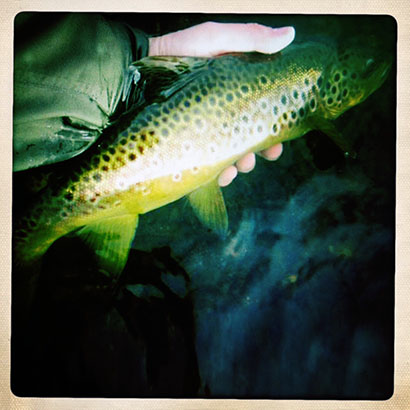 Of all the fish that swim, the one that has surely got life sussed beyond all others is the slob trout. There are arguments as to his true origin, though it is widely believed that the slob trout is a brownie (Salmo trutta) who, having spawned, then drifts downstream until he finds the food-rich estuarine water where he spends the rest of his days in a state of idle indulgence.
Of all the fish that swim, the one that has surely got life sussed beyond all others is the slob trout. There are arguments as to his true origin, though it is widely believed that the slob trout is a brownie (Salmo trutta) who, having spawned, then drifts downstream until he finds the food-rich estuarine water where he spends the rest of his days in a state of idle indulgence.
Of course, as we know, the brown trout is known already for occasionally going to sea, but before becoming a migratory sea-trout must first become a smolt – whereupon physiological changes occur that enable a freshwater fish to cope with the high salinity of the sea. A slob trout makes no such change, but is able (like many fish) to cope with brackish estuarine water.
William Yarrell, the 19th Century taxonomist believed that the slob trout (or bull trout as he called it) differed slightly from the brown, and therefore classified it as a separate species with the latin name Salmo eriox. His theory was disproved however, and though less widespread than in Yarrell’s day, the slob trout that swim today in estuaries such as the Tamar are nothing more than lazy brown trout.


Interesting piece about an issue that remains a mystery to me in some aspects. I have had a few sea/ brown trout in recent times that made me wonder. An estuary caught summer fish of 3 to 4 lbs I presumed was simply a sea trout despite it’s slightly brown/ coloured colour. Fish of a slightly smaller size taken up river in autumn that seemed to be impossible to identify with certainty whether sea trout or brown trout. Does it matter if they are genetically the same spices but with different and varied habits? I have read that many larger male sea / brown trout simply live in the river and fertilise the eggs of returning sea trout? That there will simply be a resident brown trout population in a river seems clear. That finnock (young sea trout) hang about in estuary water till they mature and that like brown trout there are different strains with different distinct physical features. The difficulty for me would be in trying to identify what stage/ form/ cycle stage a fish of say upwards of 1.5 lbs is at with any certainty. In our club I’ve seen the classification of such fish perhaps vary to suit the angler or season but have never personally felt decisions could be arrived a with certainty.